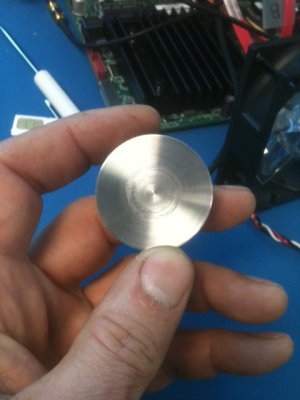- Joined
- Nov 16, 2012
- Messages
- 5,596
All,
Here are some planned test results on heat treating. The texts I'm learning from really stress proper procedure and I decided to verify if the authors are being overly cautious (with good intentions) or if it really makes a difference. Aside from passing along what I'm learning, there's a motvation in me to post this... Specifically, I occasionally hear folks here planning to heat treat a part -and sometimes the intended part is something criticical like a bucket pin or home-made parts for a hoist etc... Worse yet, sometimes the material is not precisely known.
Summary: Propoer procedure makes a difference -and a lot moreso than I imagined!
Three varying length slugs of 1045 were heat treated with an intended Rockwell of 32-C. The slugs were 1.5" diameter with lengths of 1/2", 1" and 1.5" and were fully normalized using proper technique.
Without getting into the details of the procedure, the piece shown should have had a uniform case hardening with about 0.050" depth. Since it's the smallest piece, it should have cooked the fastest and most uniformly. So... I decided to heat the piece at the low end of 1525 and started the clock as soon as the oven reached that temperature (about 1 hour) and cooked it for 30 minutes. In reality, it should have been allowed to stabilize for about 10 minutes before starting the clock and ideal temperature should have been 1550.
After the part was heat treated, the tempering process was done properly and according to the cook book.
Here's what it looks like. The piece was face turned in 0.010" increments and on the 2nd pass the soft chewy center was visible. It didn't even harden down to the desired depth. -And by the way, you've probably seen how cold-rolled steel shows this same pattern and it's proof positive that stresses are present in non-normalized material. The Rockwell tested-out at 27-C but, at the current time, the test apparatus is not verified. I'm using a rebound type and also evaluating some brinell testers. -But before making any serious investments, want to learn more about the merits of each technique.
I heat treated some of the othe parts in proper fashion and they pretty-much produced the desired results. BTW: by peeking at the color of red inside the oven, I sure has hell (pun intended) can't tell the difference in color between 1525 and 1550. Even following the cook-book, I did not achieve uniformity in the other pieces that were done properly. It was pretty close -but no cigar... Need to read/learn/experiment more... I think it's a quenching problems but at this time do not have enough knowledge to analyze the symptoms. I'm pretty sure I'll get a handle on this in the next week or so.
BTW:... somewhere along the line, I'll include some comments about the PID controller. Seems to have some glitches -not the end of the world but minor annoyances.
Ray


Here are some planned test results on heat treating. The texts I'm learning from really stress proper procedure and I decided to verify if the authors are being overly cautious (with good intentions) or if it really makes a difference. Aside from passing along what I'm learning, there's a motvation in me to post this... Specifically, I occasionally hear folks here planning to heat treat a part -and sometimes the intended part is something criticical like a bucket pin or home-made parts for a hoist etc... Worse yet, sometimes the material is not precisely known.
Summary: Propoer procedure makes a difference -and a lot moreso than I imagined!
Three varying length slugs of 1045 were heat treated with an intended Rockwell of 32-C. The slugs were 1.5" diameter with lengths of 1/2", 1" and 1.5" and were fully normalized using proper technique.
Without getting into the details of the procedure, the piece shown should have had a uniform case hardening with about 0.050" depth. Since it's the smallest piece, it should have cooked the fastest and most uniformly. So... I decided to heat the piece at the low end of 1525 and started the clock as soon as the oven reached that temperature (about 1 hour) and cooked it for 30 minutes. In reality, it should have been allowed to stabilize for about 10 minutes before starting the clock and ideal temperature should have been 1550.
After the part was heat treated, the tempering process was done properly and according to the cook book.
Here's what it looks like. The piece was face turned in 0.010" increments and on the 2nd pass the soft chewy center was visible. It didn't even harden down to the desired depth. -And by the way, you've probably seen how cold-rolled steel shows this same pattern and it's proof positive that stresses are present in non-normalized material. The Rockwell tested-out at 27-C but, at the current time, the test apparatus is not verified. I'm using a rebound type and also evaluating some brinell testers. -But before making any serious investments, want to learn more about the merits of each technique.
I heat treated some of the othe parts in proper fashion and they pretty-much produced the desired results. BTW: by peeking at the color of red inside the oven, I sure has hell (pun intended) can't tell the difference in color between 1525 and 1550. Even following the cook-book, I did not achieve uniformity in the other pieces that were done properly. It was pretty close -but no cigar... Need to read/learn/experiment more... I think it's a quenching problems but at this time do not have enough knowledge to analyze the symptoms. I'm pretty sure I'll get a handle on this in the next week or so.
BTW:... somewhere along the line, I'll include some comments about the PID controller. Seems to have some glitches -not the end of the world but minor annoyances.
Ray



